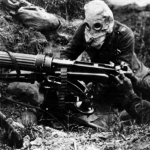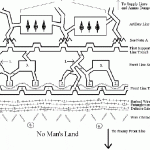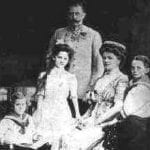Since the first successful flight of an airplane, people had imagined and dreamed of airplanes being used for combat. H. G. Wells’s 1908 book (The War in the Air was an example. When World War One broke out, there were only about 1000 planes on all sides. Planes were very basic. Cockpits were open, instruments were rudimentary, and there were no navigational aids. Pilots had to use maps, which were not always reliable. Getting lost was common. Sometimes pilots had to land and ask directions! At the beginning of the war, airplanes were seen as being almost exclusively for reconnaissance, taking the job formerly done by cavalry. Eventually, however, it became necessary for planes to eliminate the observation planes of the enemy, so air-to-air combat (dogfights) became common.
-
The Development of Combat Aircraft
-
Since the first successful flight of an airplane, people had imagined and dreamed of airplanes being used for combat. H. G. Wells (The War in the Air, 1908) was an example.
-
Planes had been used in minor wars beginning in the 1910s.
-
Each Great Power had formed air branches of the army and/or navy. France had the most developed one. Britain had two: The Royal Flying Corps (part of the army) and the Royal Naval Air Service (part of the navy). They would be merged into the Royal Air Force, the first independent air service, in 1917. The German service was called the Luftstreitkrafte.
-
When the war broke out, there were only about 1000 planes on all sides.
-
Planes were very basic. Cockpits were open, instruments were rudimentary, and there were no navigational aids. Pilots had to use maps, which were not always reliable. Getting lost was common. Sometimes pilots had to land and ask directions!
-
At the beginning of the war, airplanes were seen as being almost exclusively for reconnaissance, taking the job formerly done by cavalry. They were also used for artillery spotting and range finding. Flying reconnaissance missions was dangerous, however.
-
Eventually, however, it became necessary for planes to eliminate the observation planes of the enemy, so air-to-air combat (dogfights) became common.
-
Plane technology improved throughout the war, and specialized planes began to emerge (seaplanes, fighters, bombers). There were biplanes and triplanes. Popular makes included the Neuport, the Sopwith Pup and Sopwith Camel, and the German Fokker triplane.
-
Plane speeds increased throughout the war, from about 75 mph at the start of the war to nearly twice that at the end.
-
The air forces increased greatly in size. At the beginning of the war, the British air services had 300 officers and about 1800 men. By the end of the war, they had 27,000 officers and over 300,000 men. France had less than 140 aircraft at the start of the war but 4500 at the end of the war (the most of all powers).
-
Production of planes also increased greatly. By the war’s end, France was building as many planes every day as the total number they had at the start of the war.
-
Aircraft weaponry became more elaborate. At the beginning of the war, pilots just shot at each other with pistols or other small arms.
-
Then machine guns were installed, but the bullets would hit the propeller. Metal plates were installed on propeller blades to deflect the bullets. But the bullets would sometimes ricochet, and repeated hits would wear off the plates.
-
This problem was solved by Dutch engineer Anthony Fokker, who invented an interrupter gear that synchronized the gun’s action with the propeller. This invention gave the Central Powers air superiority (“The Fokker Scourge”) for a while, but only for about a year. After about a year, the Allies had developed this technology and the German advantage was lost.
-
-
Fighters and Fighter Tactics.
-
Flying was extremely dangerous. A large percentage of pilots were killed (50% for British pilots, for example). Of the 68,000 aircraft that France produced during the war, 52,000 were lost in combat (77% loss rate).
-
Training for pilots was, in general, inadequate. Pilots went into combat with as little as 3.5 hours of training.
-
Air tactics were virtually nonexistent at the start of the war and had to be made up as they went. WW1 pilots laid the groundwork for all future air warfare.
-
In August 1916, German ace Oswald Boelcke (honored as the father of the German fighter air force, as well as considered the “Father of Air Fighting Tactics”) developed his 8 dicta, which would be highly influential.
-
Try to secure the upper hand before attacking. Always keep the sun behind you.
-
Always continue with an attack you have begun.
-
Open fire only at close range, and then only when the opponent is squarely in your sights.
-
Always try to keep your eye on your opponent and never let yourself be deceived by ruses.
-
In any type of attack, it is essential to assail your opponent from behind.
-
If your opponent dives on you, do not try to get around his attack, but fly to meet it.
-
When over the enemy’s lines, always remember your own line of retreat.
-
In principle, it is better to attack in groups of four or six. If fights break up into single combats, pay attention that several comrades do not go after one opponent.
-
-
One of the most notable fighter actions of the war was “Bloody April”, during the Battle of Arras. The British RFC lost 245 aircraft, with 211 airmen either dead or missing and 108 becoming POWs. The RFC lost about a quarter of its strength. The average life of a replacement airman was 11 days. The Germans lost only 66 planes…a nearly 4-1 kill ratio. Despite this, the RFC was able to provide the infantry with excellent intelligence. This was the greatest percentage loss for the British in the entire war.
-
-
Fighter Aces
-
Fighter pilots who obtained 5 kills were called “aces.” Only about 5% of pilots achieved this status.
-
They were seen as “knights of the air.” They were greatly romanticized and adored. They were believed to embody chivalry and nobleness.
-
Some of the most well-known aces were Edward Mannock and Alfred Ball (British), Billy Bishop (Canadian), Rene Fonck (French), Eddie Rickenbacker (American), Hermann Goering, Ernst Udet and Manfred von Richthofen (German). Richthofen had 80 kills (the most in the war) and was called the “Red Baron.”
-
Richthofen was the leader of a fighter squadron called the “Flying Circus” which moved around from battle to battle as needed.
-
In April 1918, Richthofen was shot down, either by a Canadian pilot or Austrian ground troops who were firing on airplanes. He was only 26. Australian pilots held a funeral with full military honors for Richthofen was held by Canadian
-
-
Bombing
-
Bombing was pioneered in the First World War. At the start of the war, bomber planes mainly dropped grenades.
-
As the war progressed, however, the size of bombs grew increasingly large.
-
Bombing was used both on military and civilian targets. The Germans dropped bombs on Belgian and French cities, including Paris.
-
Zeppelins (hydrogen-filled dirigibles) were also used for bombing, primarily on British targets, beginning in 1915. By the war’s end, they could reach an altitude of 27,000 feet. (Note: the British used blimps and kite balloons, but only for observation)
-
The Germans only had 11 zeppelins at the start of the war. But they used 123 zeppelins throughout the war. About 80 were shot down or collapsed on their own.
-
The zeppelins conducted more than 50 raids on Great Britain. They caused a great deal of terror and outrage.
-
Zeppelin raids began to be phased out in 1916, when zeppelins were replaced by long-range bombers. The development of incendiary bullets made it easier to destroy zeppelins.
-
In 1917 and 1918, the Germans repeatedly bombed London (with airplanes). About 1400 British civilians were killed in these bombings.
-
British aircraft retaliated, bombing zeppelin bases and chemical weapons factories at first, and then long-distance bombing of German cities.
-
Strategic bombings were largely ineffective. Because of this, by Verdun, long-range bombing missions were phased out in favor of operations on the front.
-
-
Aircraft Carriers
-
In the early 1910s, planes first took off and landed from stationary ships. These were American planes and ships
-
In 1912, a British plane took off from a moving ship for the first time. Five years later, British Commander Edwin Dunning landed on a moving ship for the first time.
-
The first carrier-launched airstrike was the Tondern raid in July 1918. Seven Sopwith Camels launched from the converted battlecruiser HMS Furious damaged the German airbase at Tondern, Germanyand destroyed two zeppelin airships.
-
In 1918, the HMS Argus became the world’s first carrier capable of launching and recovering naval aircraft
-
This article is part of our larger selection of posts about World War One. To learn more, click here for our comprehensive guide to World War One.
Cite This Article
"WW1 Flying Aces: The Red Baron and More" History on the Net© 2000-2024, Salem Media.
July 27, 2024 <https://www.historyonthenet.com/ww1-flying-aces-the-red-baron-and-more>
More Citation Information.








